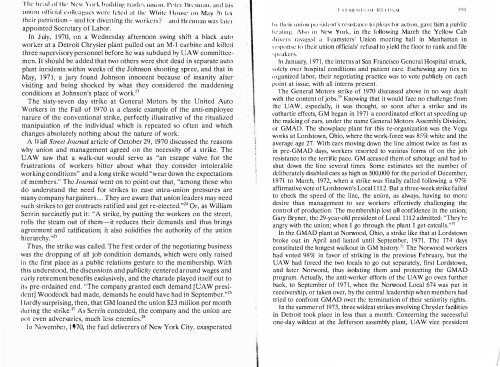CONTENTS - ouroboros ponderosa
CONTENTS - ouroboros ponderosa
CONTENTS - ouroboros ponderosa
You also want an ePaper? Increase the reach of your titles
YUMPU automatically turns print PDFs into web optimized ePapers that Google loves.
The he;,,1 of the New York 11Ilildillf', II ;Idcs IIl1ioll, P,'kr Bl'l' lIllall, allti llis<br />
lIlIioll offi(,ial colleagues were feted 'II Ihc While Iiouse 011 May .'IJ fOI<br />
their patriotism --and t(Jr diverting thc workers '! and Brcllllan as lain<br />
appointed Secretary of Labor.<br />
In July, 1970, on a Wednesday afternoon swing shift a hlack aulo<br />
worker at a Detroit Chrysler plant pulled out an M-1 carbine and killed<br />
three supervisory personnel before he was subdued hy UAW committee<br />
men. It should be added that two others were shot dead in separate auto<br />
plant incidents within weeks of the Johnson shooting spree, and that in<br />
May, 197], a jury found Johnson innocent because of insanity after<br />
visiting and being shocked by what they considered the maddening<br />
conditions at Johnson's place of work."<br />
The ' sixty-seven day strike at General Motors by the United Auto<br />
Workers in the Fall of 1970 is a classic example of the anti-employee<br />
nature of the conventional strike, perfectly illustrative of the ritualized<br />
manipulation of the individual which is repeated so often and which<br />
changes absolutely nothing about the nature of work.<br />
A Wall Street Journal article of October 29, 1970 discussed the reasons<br />
why union and management agreed on the necessity of a strike. The<br />
UA W saw that a walk-out would serve as "an escape valve for the<br />
frustrations of workers bitter about what they consider intolerahle<br />
working conditions" and a long strike would "wear down the expectations<br />
of members." The Journal went on to point out that, "among those who<br />
do understand the need for strikes to ease intra-union pressures are<br />
many company bargainers .... They are aware that union leaders may need<br />
such strikes to get contracts ratified and get re-elected."" Or, as William<br />
Serrin succinctly put it: " A strike, by putting the workers on the street,<br />
rolls the steam out of them-it reduces their demands and thus brings<br />
agreement anel ratification; it also solidifies the authority of the union<br />
hierarchy.""<br />
Thus, the strike was called. The first order of the negotiating business<br />
was the dropping of all job condition demands, which were only raised<br />
in the first place as a public relations gesture to the membership. With<br />
this understood, the discussions and pUblicity centered around wages and<br />
early retirement benefits exclusively, and the charade played itself out to<br />
its pre-ordained end. "The company granted each demand [UA W presi<br />
dent] Woodcock had made, demands he could have had in September."26<br />
I lardly surprising, then, that GM loaned the union $23 million per month<br />
during the strike ." As Serrin conceded, the company and the union are<br />
llot even adversaries, much less enemies.'"<br />
III Novemher, 1 970, the fuel deliverers of New York City, exasperated<br />
,<br />
•<br />
•<br />
•<br />
,<br />
I<br />
,.<br />
J<br />
,<br />
i<br />
:<br />
·<br />
I<br />
,<br />
'.<br />
,<br />
,<br />
I J 1'rl. Jl'N I', (II 1':'1 ' 1 (1\;\1<br />
[1\' 11wil IIl1iol1 l lll'sidl'llt's resisLllllT to pllas for action, gave hi m a puhlic<br />
"""Iillg. A lso ill New York, in the t(lllowing March thc Yellow Cab<br />






